Race Realism Is Not Enough
Reb Kittredge, American Renaissance, April 7, 2020
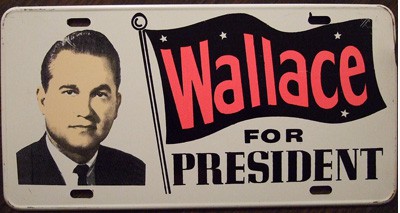
This is part of our continuing series of accounts by readers of how they shed the illusions of liberalism and became race realists.
I found out about the identitarian movement as a result of Hillary Clinton’s speech about the alt-right in August 2016. It made national news, and in reading up about it, I discovered American Renaissance and the National Policy Institute, whose websites I immediately started reading regularly. I was receptive to a pro-white worldview for two reasons. First, my upbringing: I was born in 1956, in Birmingham, Alabama — the epicenter of the civil rights movement — to parents who were thoroughly racially conscious and remained so all their lives. Second: I met professor and noted race realist Michael Levin in 1991, when he spoke at a university I was working for.
My parents bitterly opposed Brown v. Board of Education and were staunch conservatives. Our family cars displayed bumper stickers such as “Impeach Earl Warren,” “Get US Out of the UN,” “Support Your Local Police,” and “Wallace for President.” Members of the John Birch Society, they hosted meetings at our house that John Hall Buchanan Jr., a US congressman, sometimes attended. My mother had no fear of speaking her mind and fiercely defended her interests. We had many conversations about race up until her death. She talked about “the black race,” how they “were different” and had “different ways.” She warned that many blacks hated whites and carried knives and razor blades.
My childhood home’s bookshelf sported copies of rightist books of the sort William F. Buckley kept his distance from: None Dare Call it Treason by John A. Stormer and I Found God in Soviet Russia by John H. Noble, to name just two. When my mother read to me as a child, most of the books she chose were politically incorrect classics: Helen’s Babies, Huckleberry Finn, The Adventures of Tom Sawyer, and Uncle Remus. Both my mother and my father performed in minstrel shows in church, often in black face, singing favorites such as “Lulu’s Back in Town.” One old spiritual my father sang around the house went: “Now some folks say that a nigger won’t steal / Way down yonder in the cornfield / But I saw one the other day / Way down yonder in the cornfield.”
The Magic City was a lovely place in the 1950s and early 1960s. Everyone dressed well, including blacks. The city had little crime. The downtown had the beautiful Alabama Theatre and department stores such as Pizitz and Loveman’s. Downtown was so safe my parents let me take the bus there as a child. Blacks had their own houses — not apartments or public housing — in nice neighborhoods that were perfectly safe for whites to enter.
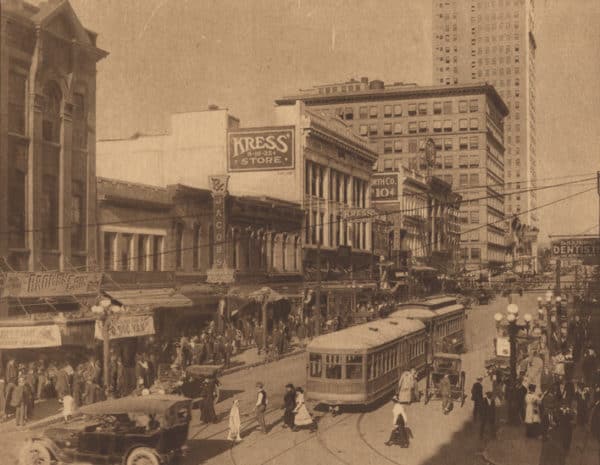
Birmingham, Alabama in 1915.
My parents hired black women to work as maids and black men to help my father with lawn work and other projects, and the same was true at the homes of my cousins. Some of the help were such beloved family friends I kept in touch with them even after moving away. Although my parents were fierce opponents of integration, they were, like most Southerners, polite and even kindly toward blacks. But they had no illusions about them. Their views on race were perfectly congruent with Carlton Putnam’s Race and Reason, a book that sheds light on Birmingham’s predicament in 1960. The black family we knew best was the Howells. Mae, who had run off her no-good husband Lee, had (I think) five children. I remember James, Lee Jr., Tony and Frazier. Mae was determined her children would receive fine educations and make something of themselves.
Many years later, James and his family came to visit us while they were in town. He lived in Washington state where he had a long career with the park service. He wanted us to see how well he had done. Later still, when I was home from graduate school, Frazier turned up in dramatic fashion. I saw a new canary yellow Corvette coming down the driveway. When I opened the front door, a well-dressed black woman introduced herself — it was Frazier! She had been seeing the world as a Navy nurse. My last experience with Tony, the boy closest in age to me, didn’t go as well. I was around 13 years old and Tony came to our house to play. I hadn’t seen him in a few years. As we walked through the front yard, he said: “I’d like to cut you.” “What?” I said. “What’s a little cut between friends?” he replied. I stepped back, aghast. I walked quickly to the house and never saw him again.
The “firm but gentle” approach to interacting with blacks that my parents taught me has served me well. On one trip home soon after my father died in 1983, I was visiting my mother. A young black man named Ted had been helping out around the house. My father kept his two guns — an M1 carbine and an M1911 .45 semi-automatic pistol — in his closet behind a false wall. He had sawed out a wall panel, attached it by magnet, and covered it with a tie rack. I removed the panel to find the pistol missing from the shelf where it belonged. I called out, “Ted, I know you took my father’s pistol and I want it back. Put the gun on the ping pong table on the porch. I won’t come out. If it’s there in the morning, no questions asked. If it’s not there, I’m coming to get it.” He said “Alright,” and the next morning the gun was on the table. Needless to say I took the guns with me, and that was the end of it.
But Birmingham changed dramatically during the ‘80s and ‘90s. Vagrants and prostitutes walked the streets. White flight, which had gone mostly to the south of town, had turned Highway 280 — a once-lovely two lane road that wound through the countryside — into an 8-lane torrent of traffic. Entire areas of the city went black. It was like floodwaters spreading out of downtown and into the suburbs and countryside. The decline came with increasing vitriol and blame directed against whites. For a long time I couldn’t understand it. Why now? Why, the farther we moved from slavery and segregation, was resentment increasing? Why were blacks doing worse than before?
During this time, I hired a white man to do some work on my mother’s house. He brought his teenage son along, who I learned went to my alma mater, Huffman High School. I asked how he liked it. He hung his head. His father, too, had a downcast expression. The school, unbeknownst to me, was now 90-percent black. When I started high school in 1970, it was completely white, as my elementary school had been. By graduation, there were only a handful of black students. But now the black kids bullied the whites and carried weapons. School authorities couldn’t control them. When I went to the Huffman High School’s web site, I found that even our mascot, a viking, was now black. Will our beautiful statue of Vulcan on Red Mountain, the biggest cast iron statue in the world, go black too? Or might it be replaced by a Mexican wielding a leaf blower? At least that would be accurate.

Around the same time, I visited Frog Pond, a cypress swamp in an older black area. As I stood by the swamp, a young black man came walking by. We greeted each other and ended up speaking for a while. Toward the end of our chat, he took some junk food item wrapped in plastic out of his coat. When he finished it, he threw the wrapper on the ground. The shore was strewn with trash. “How could you do that” I asked, “in such a beautiful place, or anywhere for that matter?” He just shrugged.
My end of town eventually went mostly black, too. Virtually every business closed. Soon there were no grocery stores left. Our next-door neighbor of more than 50 years, an elderly widow, was robbed at gunpoint at her front door — the last straw for her. Burglaries, car jackings, and shootings were common, as were thefts of Social Security checks from retirees’ mailboxes. Rap music boomed from passing cars.
Then my mother had a stroke and was mostly paralyzed from the waist down. She moved into a series of nursing homes, which were staffed by black nurses. One facility was closed because the staff was dealing drugs. They routinely entered her room without knocking, hung out and talked loudly to one another, “butchering the English language” as my mother put it. Worst of all was when negligence on the part of black staffers landed her a broken arm. My family sought legal counsel over the incident, but proving abuse is difficult without witnesses. We won concessions from the nursing home and got troublesome staff barred from entering her room, but never achieved a satisfactory solution. Furthermore, we had to consider the possibility of retribution against any gains made. That facility was the third and best she’d stayed in. My sister and I eventually had to sell the family home to raise money to keep my mother in a private room. The beautiful two-story house that my father built on two acres fetched only $45,000. As it stood vacant, attempted break-ins occurred every week.
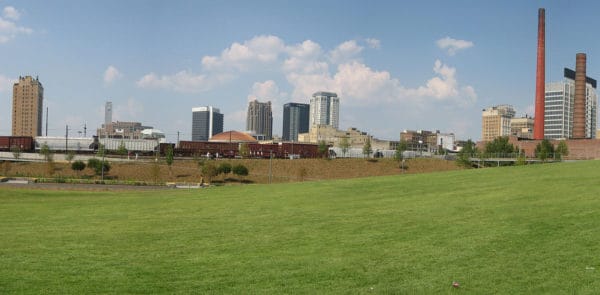
Birmingham, Alabama in 2011. (Credit Image: Jpwhitmore / Wikimedia)
During the 2000s, Birmingham underwent a renaissance of sorts. There were already two Frank Beard Award-winning chefs in town, and their restaurants were bright spots amid the blight. The pro-business black mayor took measures to revive the downtown, and new lofts started going up. Regions Bank built a minor league baseball stadium for the Barons that won an award for the most beautiful in the country. The “Free the Hops” movement prevailed and breweries sprang up in old industrial buildings. The University of Alabama Birmingham (UAB), my alma mater, emerged as a major medical research institution. Led by “pioneers,” many awful neighborhoods came back. The old department stores, closed for decades, became food courts and malls. Birmingham became a destination.
Recovery stalled in neighborhoods that had apartment buildings. During the 1960s, many beautiful houses were torn down. Some fell to UAB, which built drab uninspired structures that Roger Scruton would decry; others, to an airport runway expansion that never took place. But many were razed to make way for multi-unit apartment buildings. Virtually all the crime on the Southside comes from such apartments and from South Town, an all-black public housing project the city plans to destroy this year. Another problem has been the new black mayor, who has different priorities from the previous one. He tried to name the Birmingham CrossPlex after the late, former mayor and felon Larry Langford. Last year, the mayor covered a Confederate monument, in defiance of state law. Meanwhile, monuments in the Civil Rights District are sacrosanct. Kelly Ingram Park features bronze statues of black protesters cowering before policemen and their snarling dogs.
Things are better now, but far from ideal. While visiting the “new” Birmingham, I likely thwarted two attempted muggings. On each occasion, a young black man was shadowing and eyeing me from across the street, walking in the same direction a little behind me. When the man crossed the street toward me, I turned abruptly and crossed the street behind him. Both times the men shouted “Hey!” and issued forth some kind of condemnation for suspecting them because they were black. Both times I was carrying a concealed pistol but didn’t have to draw it.
Miami, which I moved to in 1979 for graduate school, was another racial cauldron, albeit of a different mix. I lived in Coconut Grove, a beautiful area alongside Biscayne Bay. The “black Grove” and “white Grove” were separated by one street, but the difference was night and day. One night in 1980, my apartment complex was having a pool party when someone showed up and announced that the black Grove was on fire. We walked over a couple of blocks and saw burning cars and chaos. It was the beginning of the McDuffie riots. Arthur McDuffie was a black motorcyclist killed by police officers during a struggle that ended a high-speed chase. When the policemen involved were acquitted, Miami’s blacks rioted. Curfews were imposed and thousands of National Guardsmen were brought in to keep order.
Incredibly, that was the calm before the storm, as the “Mariel boatlift” came not long after. Until then, Miami had a strong Cuban influence, but retained its American identity. The “Marielitos” changed that, and shot the crime rate up to boot. A sampling: A woman was decapitated and her head was tossed from a moving car in Coconut Grove; a couple sitting by the bay on the Rickenbacker Causeway was murdered. Bars on windows appeared everywhere. Within several years the character of Miami was unrecognizable. By the time I began my job at a university in Ft. Lauderdale in 1985, south Florida was in the grips of the Cocaine Wars. The Miami Herald published weekly maps showing where bodies were found, the work of the “Cocaine Cowboys” from Colombia vying for territory. Even still, I was surrounded by liberal academics, and didn’t think much about race or immigration.
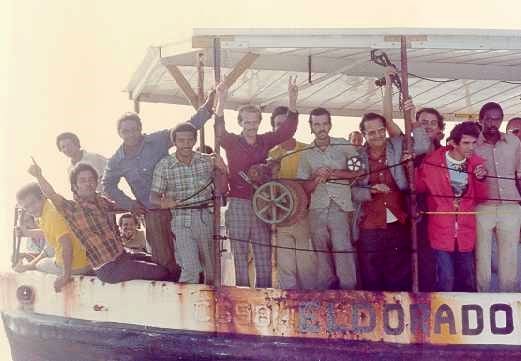
Inbound “Marielitos,” 1980.
A visit to my campus by Michael Levin in 1991 awakened me from my dogmatic slumber. Since I had read Levin’s Metaphysics and the Mind-Body Problem in graduate school, I was a big fan of his and looked forward to meeting him. The event occurred during Prof. Levin’s troubles at City College in New York, where his frank comments about race led to legal battles. My dean asked me to serve as a panelist for his talk, and circulated copies of court transcripts that I still have. They make for fascinating reading. Prof. Levin’s talk was a defense of freedom of inquiry, but he never mentioned race or his own situation. At his talk there were some menacing looking blacks in attendance and security was tight. Afterwards, we exchanged letters, mostly about philosophical topics, but his work on race also came up. My reaction to the articles he had written, and later his masterful book Why Race Matters, was: The South was right and my parents were right.
I spent the summer of 1995 in Chicago as a participant in a National Endowment for the Humanities seminar at the University of Chicago. The experiences I had there reinforced what I had learned. It’s a rough city now, and it was a rough city then. One of the first things that happened to me was having my keys stolen from my gym bag. Uncomfortable and menacing encounters with blacks were commonplace. In The Loop and around Rush Street, aggressive black panhandlers were unavoidable. On two occasions I thought I’d be attacked after I refused to give them money.
One day as I walked down the sidewalk a group of young black men were walking toward me, four abreast, taking up the whole sidewalk. As they drew near, it became clear they were making no effort to allow me space to pass. I made a decision to stay my course and not step into the street. Sure enough, the one closest to me did not move aside and we collided, banging shoulders. I wheeled around, ready to fight. They turned and stared at me, but when I stood my ground they walked on. The Southside looked like a war zone. When I went there to visit the oldest blues club in the city, The Checkerboard, I discovered that the almost exclusively white visitors were encouraged to park in a lot enclosed by a high chain link fence topped with razor wire.
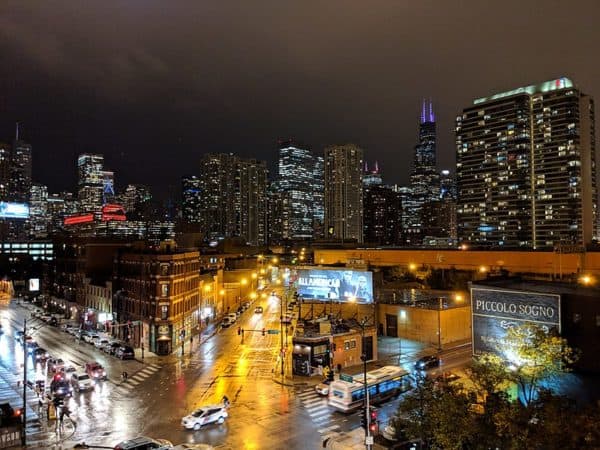
Chicago (Credit Image: Ikmckenz / Wikimedia)
And yet, I still hadn’t put it all together. There was something missing. It was white identity: a positive thesis about us. I got that from Jared Taylor’s videos. Race realism was necessary but not sufficient for white consciousness. I was one of those whites who voted for Barack Obama. I despised neoconservatives and their endless wars, and Mr. Obama opposed the Iraq War. I was largely unaware of the immigration problem outside of south Florida. Well, I got on board very quickly and have been reading authors in the movement ever since. Every day now, I spend time on pro-white websites.
Recently, I retired and moved back to Birmingham after 40 years. I live in a nice, white, safe neighborhood located next to a wealthy area. But it is an oasis. The local news begins each morning with reports of shootings and killings. I carry a gun whenever I leave the house. As I rediscover my state, I look for small cities or towns where I could move in case the situation for whites in Birmingham deteriorates. I divide my life into three parts: family, philosophy, and white identitarianism. I was born into the best of families in the most confusing of times. I allowed my white consciousness to dim for a while. But then it returned, and now, thanks to American Renaissance, it burns brighter than ever.
If you have a story about how you became racially aware, we’d like to hear it. If it is well written and compelling, we will publish it. Use a pen name, stay under 1,200 words, and send it to us here.















